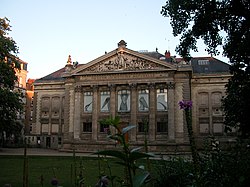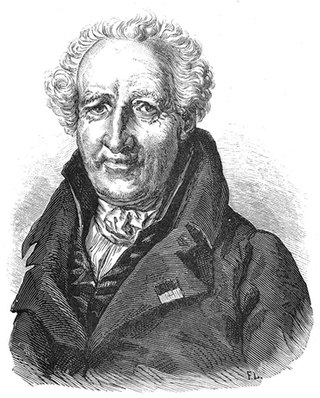
Antoine Laurent de Jussieu was a French botanist, notable as the first to publish a natural classification of flowering plants; much of his system remains in use today. His classification was based on an extended unpublished work by his uncle, the botanist Bernard de Jussieu.

Nantes is a city in Loire-Atlantique on the Loire, 50 km (31 mi) from the Atlantic coast. The city is the sixth largest in France, with a population of 314,138 in Nantes proper and a metropolitan area of nearly 1 million inhabitants (2018). With Saint-Nazaire, a seaport on the Loire estuary, Nantes forms one of the main north-western French metropolitan agglomerations.
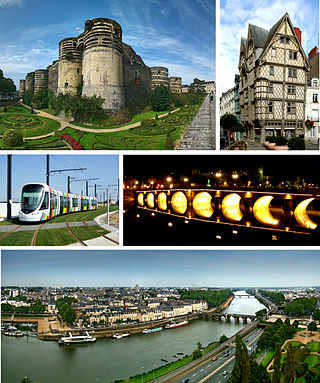
Angers is a city in western France, about 300 km (190 mi) southwest of Paris. It is the prefecture of the Maine-et-Loire department and was the capital of the province of Anjou until the French Revolution. The inhabitants of both the city and the province are called Angevins or, more rarely, Angeriens.

The Jardin des plantes, also known as the Jardin des plantes de Paris when distinguished from other jardins des plantes in other cities, is the main botanical garden in France. The term Jardin des plantes is the official name in the present day, but it is in fact an elliptical form of Jardin royal des plantes médicinales, which is related to the original purpose of the garden back in the 17th century.

Bernard-Germain-Étienne de La Ville-sur-Illon, comte de Lacépède or La Cépède was a French naturalist and an active freemason. He is known for his contribution to the Comte de Buffon's great work, the Histoire Naturelle.

Nicolas Thomas Baudin was a French explorer, cartographer, naturalist and hydrographer, most notable for his explorations in Australia and the southern Pacific.

The French National Museum of Natural History, known in French as the Muséum national d'histoire naturelle, is the national natural history museum of France and a grand établissement of higher education part of Sorbonne Universities. The main museum, with four galleries, is located in Paris, France, within the Jardin des Plantes on the left bank of the River Seine. It was formally founded in 1793 during the French Revolution, but was begun even earlier in 1635 as the royal garden of medicinal plants. The museum now has 14 sites throughout France.

The Museum of Natural Sciences of Belgium is a museum dedicated to natural history, located in Brussels, Belgium. The museum is a part of the Royal Belgian Institute of Natural Sciences. Its most important pieces are 30 fossilised Iguanodon skeletons, which were discovered in 1878 in Bernissart, Belgium.

Fabrice Hybert, also known by the pseudonym Fabrice Hyber, is a French plastic artist born on 12 July 1961 in Luçon (Vendée). At 56, he was elected to the Academy of Fine Arts on April 25, 2018.
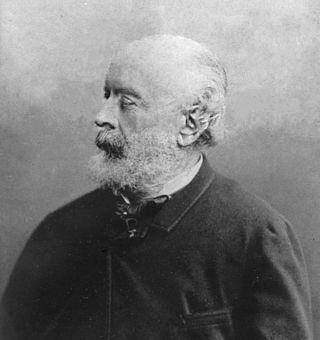
Évariste Vital Luminais was a French painter. He is best known for works depicting early French history and is sometimes called "the painter of the Gauls".

The ménagerie du Jardin des plantes is a zoo in Paris, France, belonging to the botanical garden Jardin des Plantes. Founded in 1794, largely with animals brought from the royal zoo of the Palace of Versailles, abandoned because of the French Revolution, it is the second oldest zoological garden in the world. Today it does not have very large animals like elephants, but a lot of rare smaller and medium-sized mammals and a variety of birds and reptiles.
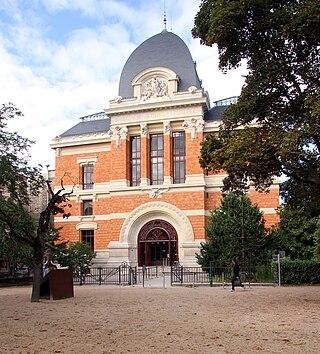
The Gallery of Paleontology and Comparative Anatomy is a part of the French National Museum of Natural History. It is situated in the Jardin des plantes in Paris near the Gare d'Austerlitz.
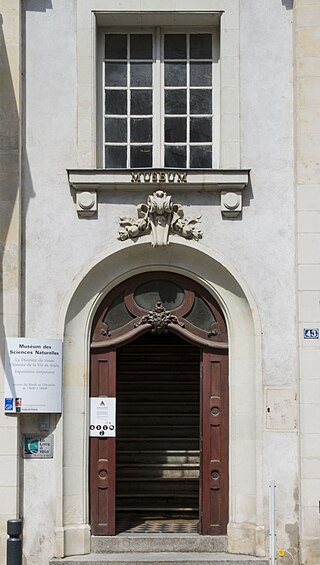
The Muséum des sciences naturelles d'Angers is a municipal museum in Angers. Dedicated to Natural History, the Muséum d'Angers houses in its collections about 530,000 objects, including 3,000 birds, 20,000 shells, 50,000 fossils, 80,000 insects and 350,000 herbarium samples, as well as hundreds of specimens taxidermised or in liquid, skeletons, minerals, technical instruments and Documents. The Muséum d'Angers receives annually about 20,000 visitors, as well as school groups, interns, researchers and volunteers.
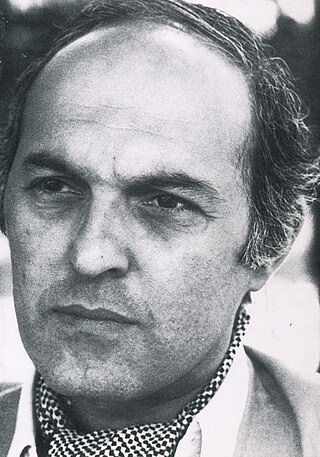
Goudji is a French sculptor and goldsmith of Georgian origin who was born in Soviet Georgia.

The Museum of Aquitaine is a collection of objects and documents from the history of Bordeaux and Aquitaine.

The Royal Museum of the Armed Forces and Military History is a military museum that occupies the two northernmost halls of the historic complex in the Parc du Cinquantenaire/Jubelpark in Brussels, Belgium. The park is set on the continuation of the Rue de la Loi/Wetstraat, which starts at the end of Brussels Park before the Royal Palace.

The Musée d'Ethnographie du Trocadéro was the first anthropological museum in Paris, founded in 1878. It closed in 1935 when the building that housed it, the Trocadéro Palace, was demolished; its descendant is the Musée de l'Homme, housed in the Palais de Chaillot on the same site, and its French collections formed the nucleus of the Musée National des Arts et Traditions Populaires, also in the Palais de Chaillot. Numerous modern artists visited it and were influenced by its "primitive" art, in particular Picasso during the period when he was working on Les Demoiselles d'Avignon (1907).

The Friends of the Natural History Museum is a French non-profit organisation, created in 1907 and recognized as a charity in 1926. Its purpose is to give practical and financial support to the Muséum national d’Histoire naturelle in Paris, France, enrich its collections, zoo, laboratories, greenhouses, gardens and libraries, and to promote scientific research and education related to it.
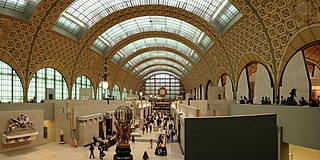
The 136 museums in the city of Paris display many historical, scientific, and archeological artifacts from around the world, covering diverse and unique topics including fashion, theater, sports, cosmetics, and the culinary arts.

Geneviève Meurgues was a French explorer, museologist, curator, conservator, chemical engineer and lecturer. As a professor at the Muséum national d'histoire naturelle, she specialised in the conservation of natural history specimens. She is noted for the preservation of the Roman boat found in Marseille and for her contribution to the establishment of the grande galerie de l'évolution du Muséum national d'histoire naturelle in Paris.
